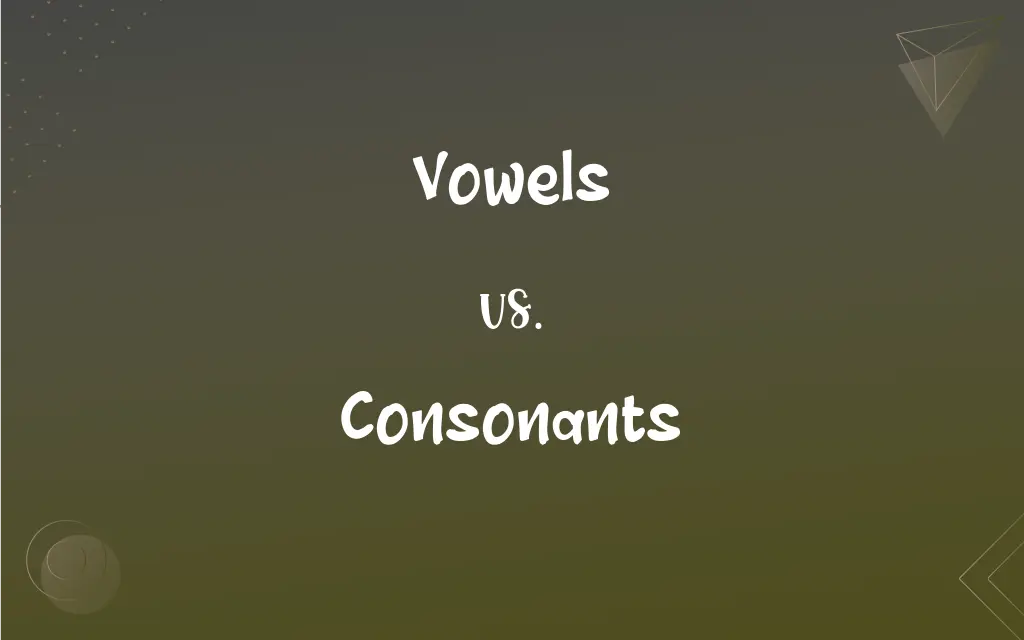Vowels vs. Consonants: What's the Difference?
Edited by Janet White || By Harlon Moss || Published on November 26, 2023
Vowels are speech sounds pronounced without any stricture or closure in the vocal tract, while consonants have some form of constriction.

Key Differences
Vowels are the nucleus of syllables in words, essential for the clarity and melody of speech. They are characterized by the open vocal tract that facilitates their sound. Consonants, contrastingly, are articulated with partial or complete closure of the vocal tract, offering a range of distinctive sounds.
Both vowels and consonants are fundamental building blocks of words in languages. Vowels often carry the tonal quality of a word, allowing for variations in pitch and emphasis. Consonants provide the rhythm and structure, distinguishing words from one another and aiding in comprehension.
In the English language, there are five main vowels represented by the letters: A, E, I, O, U. These letters can produce various sounds based on their placement in a word and the influence of surrounding consonants. Consonants, on the other hand, make up the remaining 21 letters of the English alphabet, with some producing multiple sounds.
Vowels can be elongated, producing long and short sounds, giving depth and variation to words. They can be found in every English word, even if represented by a non-vowel letter, like the 'y' in "rhythm." Consonants, conversely, provide crispness to words, often determining a word's beginning and end.
Understanding the interplay between vowels and consonants is crucial for proper pronunciation, reading, and comprehension. While vowels provide the tone and fluidity, consonants offer the defining boundaries, ensuring words are distinctly recognized and understood.
ADVERTISEMENT
Comparison Chart
Position in Words
Usually the nucleus of syllables.
Often at the beginning or end of syllables.
Articulation
Open vocal tract.
Partial or complete closure of the vocal tract.
Number in English Alphabet
5 main vowels: A, E, I, O, U.
21 letters, some with multiple sounds.
Role in Language
Provide tonality and melody.
Offer rhythm, structure, and word distinction.
Presence in Words
Found in every English word.
May not be present in every word.
ADVERTISEMENT
Vowels and Consonants Definitions
Vowels
Speech sounds made with an open vocal tract.
The word apple begins with a vowel sound.
Consonants
The letters in the alphabet other than A, E, I, O, U.
C and T are consonants in the word cat.
Vowels
Letters A, E, I, O, U in the English alphabet.
E and I are both vowels in the word elite.
Consonants
Elements that distinguish word sounds and meanings.
Changing the consonants in bat can produce cat or mat.
Vowels
The tonal components of spoken language.
The vowels in melody give the word its tuneful sound.
Consonants
Sounds that provide structure to words.
Consonants frame the word frame.
Vowels
The nucleus of syllables in linguistic terms.
In creation, the vowels form the core sounds of each syllable.
Consonants
Sounds articulated with varied mouth positions.
The consonants p and b differ by voice vibration.
Vowels
Sounds that can be elongated in speech.
The vowel in see can be lengthened for emphasis.
Consonants
Speech sounds articulated with some form of constriction.
The consonants s and t give street its distinct start and finish.
Vowels
A speech sound, such as (ē) or (ĭ), created by the relatively free passage of breath through the larynx and oral cavity, usually forming the most prominent and central sound of a syllable.
Consonants
Being in agreement or accord
Remarks consonant with our own beliefs.
Vowels
A letter, such as a, e, i, o, u, and sometimes y in the English alphabet, that represents a vowel.
Consonants
Corresponding or alike in sound, as words or syllables.
Vowels
Plural of vowel
Consonants
Harmonious in sound or tone.
Consonants
A speech sound produced by a partial or complete obstruction of the air stream by any of various constrictions of the speech organs, such as (p), (f), (r), (w), and (h).
Consonants
A letter or character representing such a speech sound.
Consonants
Plural of consonant
FAQs
What are vowels?
Vowels are speech sounds made with an open vocal tract, represented by A, E, I, O, U in English.
What distinguishes consonants from vowels?
Consonants involve some form of constriction in the vocal tract, while vowels do not.
How many main vowels are in the English language?
There are five main vowels: A, E, I, O, U.
Why are vowels essential in speech?
Vowels provide the tonality and fluidity in speech, making words distinguishable and melodious.
Can consonants form a word by themselves?
Rarely in English; most words have vowels, but some, like "rhythms," use 'y' as a vowel.
Can a letter function as both a vowel and a consonant?
Yes, for example, 'Y' in "yellow" (consonant) and "myth" (vowel).
Can a word be spoken without vowels?
Every English word has vowel sounds, but they might be represented by non-traditional vowel letters.
What role do consonants play in rhyming?
Consonants, especially at word endings, often determine rhyme patterns in poetry.
Do all languages have the same vowels and consonants?
No, different languages have unique sets of vowels and consonants.
Are vowels always voiced sounds?
Typically, yes, as they originate from open vocal tract positions.
Do consonants carry tonal information in English?
Not like vowels, but consonants do influence rhythm and emphasis.
Why are there more consonants than vowels in English?
Consonants offer a wider range of sounds due to varied mouth positions and closures, enhancing language diversity.
Why do some consonants sound similar?
They might share a place of articulation but differ in voicing, like "f" (voiceless) and "v" (voiced).
How can vowel sounds change word meaning?
Changing a vowel can turn "bit" to "bat" or "bet," altering the word's meaning.
How do consonants affect word pronunciation?
Consonants provide structure, rhythm, and clarity, distinguishing word boundaries and meanings.
Can the same vowel sound be represented differently in writing?
Yes, like the sound /i:/ can be written as "ee" in "tree" or "ea" in "sea."
Can vowels be silent in words?
Yes, such as the 'e' in "cake."
How can we categorize consonants?
Consonants can be categorized by place of articulation (like dental, bilabial) and manner (like fricative, plosive).
Why do consonants vary so much in pronunciation?
Consonant sounds are influenced by their position in a word and surrounding vowels and consonants.
How many consonants are in the English alphabet?
There are 21 consonant letters, though some can produce multiple sounds.
About Author
Written by
Harlon MossHarlon is a seasoned quality moderator and accomplished content writer for Difference Wiki. An alumnus of the prestigious University of California, he earned his degree in Computer Science. Leveraging his academic background, Harlon brings a meticulous and informed perspective to his work, ensuring content accuracy and excellence.
Edited by
Janet WhiteJanet White has been an esteemed writer and blogger for Difference Wiki. Holding a Master's degree in Science and Medical Journalism from the prestigious Boston University, she has consistently demonstrated her expertise and passion for her field. When she's not immersed in her work, Janet relishes her time exercising, delving into a good book, and cherishing moments with friends and family.































































